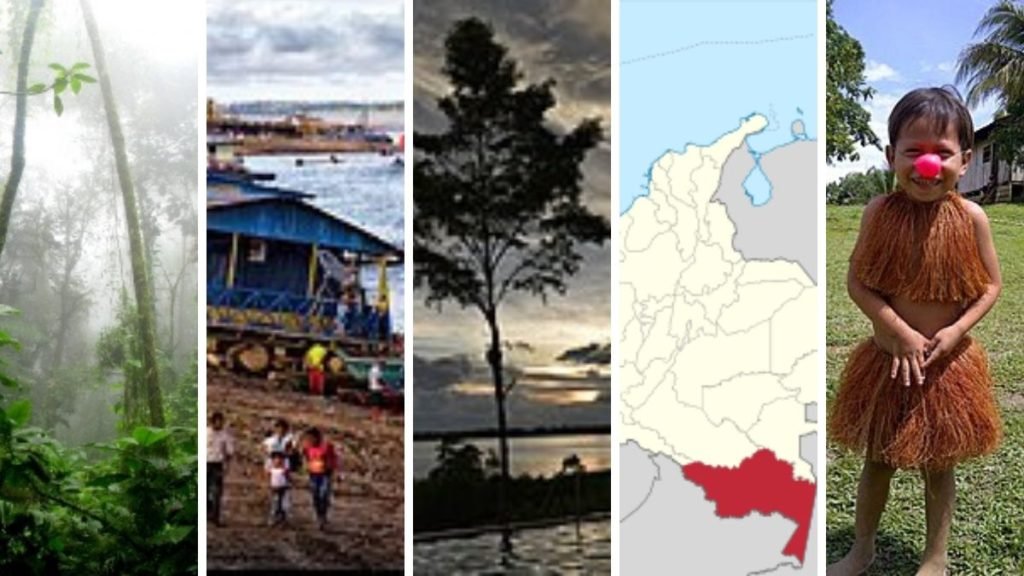
When we talk about the Colombian Amazon, we may be referring to two different geographical areas.
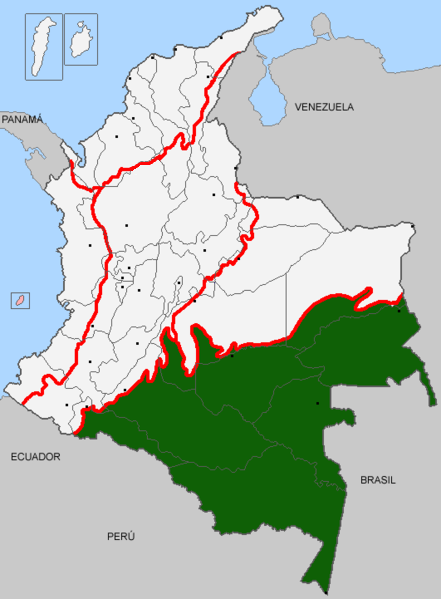
Source: NeledIthil / Public domain

Source: canislupusarctos / CC BY-SA
The political-administrative division, known as the Department of Amazonas, covers an area of 109,665 km2, which represents 9.6% of the total area of the national territory. Some 80,000 people live in the area, and the capital city is Leticia .
However, when we talk about the Colombian Amazon, we may also be referring to the Colombian Amazon Region (RAC) that covers more than a third of the country and represents approximately 5.52% of the hydrographic basin of the river Amazon. This area is dominated by tropical rainforest and has a relatively low population density of barely one million people. It also has one of the highest biodiversity indices in the world.
Colombian Amazon Region (RAC)
The Amazon Region of Colombia (RAC) includes not only the department of Amazonas but also the departments of Vichada, Guainía, Vaupés and Guaviare.
The south of the department of Meta and the east of the department of Caquetá are also part of the Colombian Amazon.
Its surface is estimated in a range that goes from 399,183 km2 to 483,164 km2 (according to different criteria).
It covers the eastern slope of the Andean mountain range, the foothills, the plains, mountains, mountains, mountains, hills and all the bodies of water included in these geographical areas.
Tributaries of the Amazon River
Although the Amazon River crosses just 116 km of Colombian territory, there are many tributaries. The most important are the Guaviare, Guainía, Caquetá, Putumayo, Chingual (Aguarico), Vaupés, and Mecaya rivers.

The main rivers of the Colombian Amazon are the Guaviare, Guainía, Caquetá, Putumayo, Chingual, Vaupés, Mecaya, and Amazonas. This last runs only 116 km inside the Colombian territorty.
Biodiversity
Due to the Orinoco River Basin, which is shared with Venezuela, Colombia places second in the world when it comes to the greatest diversity of fish. The 995 species in Colombia are surpassed only by Brazil, which has more than 2,000 species. If we exclude the species typical to the Orinoco River Basin, there remains 685 species of fish.
With regard to reptile species in South America, Colombia has the second largest number of turtle species and the greatest diversity of crocodiles or caimans.
Indigenous population
Towards the end of the 20th century, approximately 79,000 indigenous people lived in the Colombian Amazon. They formed part of 58 indigenous communities. The majority of these groups had a maximum of 500 people each and lived in the Department of Vaupés.

According to the Colombian National Administrative Department of Statistics (DANE) in 2007 there were 52 indigenous peoples in the Colombian Amazon.
Economy
Since the 1800s, the Colombian Amazon, like other Amazon regions, has been an important source of raw material for international markets.
First came the extraction of rubber , wild animal skins, and wood during the 19th century. Later came the exploitation of oil and coca which peaked in the 20th century.
Traditionally, the Amazonian indigenous peoples of Colombia practice four subsistence economic activities: fishing, hunting, gathering wild fruits, and small farm (chacras or chagras) agriculture.
The main source of protein for the people comes from 33 species of fish. Fishing is traditionally done with the use of barbasco .
The hunting of wild animals is a secondary activity. Due to limited food preservation methods in the most rural areas, captured animals are distributed among all the members of the community or delivered to neighboring communities. This sharing generates and strengthens ties or alliances.More recent economic activities include fish farming and tourism.
Sightseeing
Top among the tourist places of the Colombian Amazon are the following: Aguas Claras Natural Reserve, Santander Park, Mundo Amazónico Ecological Park, Micos Island, Amacayacu National Natural Park, and the cities of Tabatinga and Puerto Nariño.
December 7, 2020
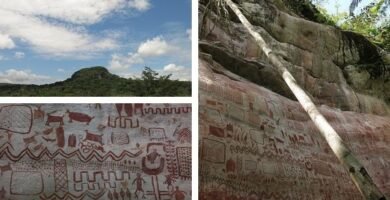
Awesome Ice-Age Cave Paintings in Colombia – Serranía de la Lindosa
November 28, 2020
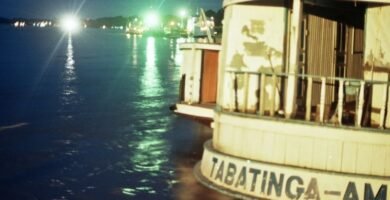
Tabatinga
November 26, 2020
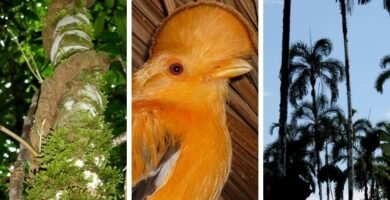
Sanctuary of Medicinal Plants Orito Ingi Ande
November 24, 2020
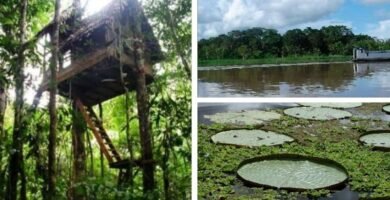
Aguas Claras Wildlife Reserve
November 21, 2020

Puerto Nariño, Colombian Amazon Rainforest
November 19, 2020
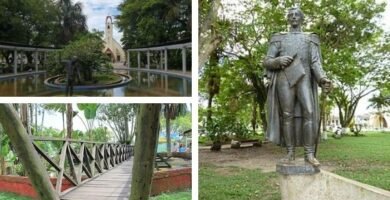
Santander Park (Leticia)
November 17, 2020
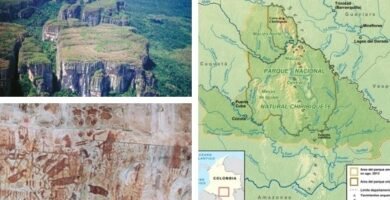
Serrania de Chiribiquete National Natural Park
November 14, 2020
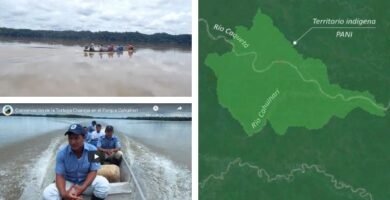
Cahuinari National Nature Park
November 12, 2020
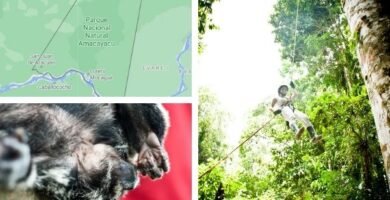
Amacayacu National Park
You can enjoy various activities such as tree climbing, jungle walks, canopy, and navigating the Amazon River.
In addition, there are tours to observe the fauna and flora. Tours start at a river crossing where you can see the beautiful pink dolphins as well as the largest lotus flowers in the world (leaves measure up to a meter in diameter).
Other tourist packages may include sleeping in ancestral trees or sharing a day with the indigenous communities that live in the area.
These are some of the hotels in the Colombian Amazon: Hotel Waira Leticia; Waira Suites; Hotel Decameron Amazonas; Decalodge Ticuna; Hotel Amazon Bed And Breakfast; Kurupira Floating Cabin; Hotel La Ceiba, Amazonas; Hostel Casa de las Palmas; Hotel Yurupari; Hotel Madreselva; Hotel On Vacation; Hotel Anaconda; Naineku lodge; and Hotel Lomas del Paiyu.
Colombian Amazon gastronomy
Typical dishes are morrocoy turtle eggs, monkey, tapir, capybara, and boa. The meat is often smoked loin with lemon, vinegar, and potato.
Rivers provide fish which is often eaten with cassava, banana, and fruits such as copoazu and anon. Dishes are influenced by what can be extracted from the rivers.
The pirarucú, a fish that grows up to three meters, and yucca are common foods. Fish forms the basis of the Amazonian diet and is sought after by tourists.
Guerrilla and drug trafficking
The leftist guerrillas (ELN, FARC), and the subsequent paramilitarism, have displaced local people who seek sources of income to improve their quality of life. These military conflicts that have penetrated the Colombian Amazon are coupled with foreign conflicts and violence and backed by political ideologies.
The political conflicts most affect the northwestern region including the Departments of Caquetá, Guaviare, and Putumayo.
The southeastern regions of Guainía, Vaupés, Amazonas, Vichada and the rest of Caquetá, and Putumayo are more isolated. They are away from highways and less penetrable. Here the indigenous subsistence economy remains; however, this production generates little or no commercial surplus.
After the fall of the Soviet Union, the Colombian guerrilla movements needed alternative financing to purchase weapons and maintain of their troops. They boosted the illicit coca cultivation in Amazonian lands that were under military control.
The increase in coca and cocaine production than began in the late 1980s brought about devastating consequences.
Fires multiplied, and there was extensive deforestation of jungle areas for the planting of illicit crops.
The Amazonian inhabitants were affected by the disintegration of their family unit; the prostitution of indigenous women; increased insecurity and violence, and an artificial market economy with extremely poor human development.
Department of Amazonas (Colombia)
The Colombian Department of Amazonas is located in the extreme south of the country. It borders in the east with the Department of Loreto (Peru) and on the west with the state of Amazonas (Brazil). The capital city, Leticia, is home to 60% of the total population.
Leticia
The most important city in the Colombian Amazon is Leticia. It is the capital of the Department of Amazonas, and it is located 1,085 km from Bogotá; however, there are no roads that connect it to the country’s capital.

Leticia is accessible by air from General Alfredo Vásquez Cobo International Airport or by river from its port on the Amazon River. The port has intense commercial activity.
Related Posts
October 24, 2019
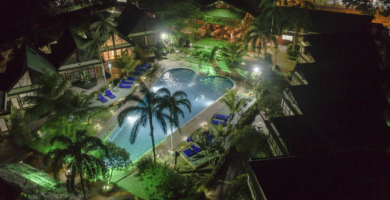
Hotels in Leticia (Colombia): Top 10
October 24, 2019

Tourist Attractions of the Colombian Amazon Rainforest
Other Amazon countries
October 5, 2019
Ecuadorian Amazon Rainforest
October 5, 2019
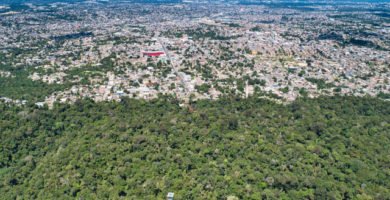
Brazilian Amazon Rainforest
October 5, 2019
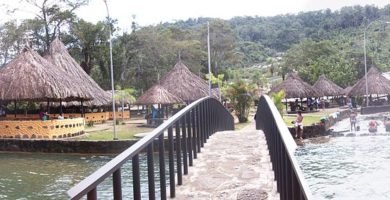
Venezuelan Amazon Rainforest
October 5, 2019
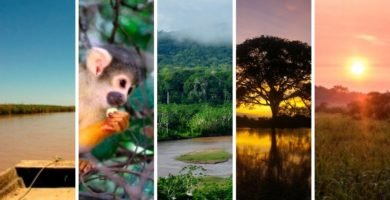
Bolivian Amazon Rainforest
October 5, 2019
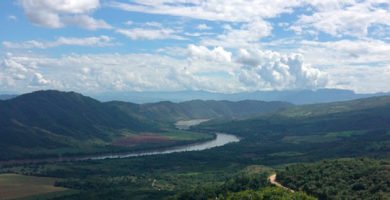
Peruvian Amazon Rainforest
This post is also available in:
![]() Español (Spanish)
Español (Spanish)
